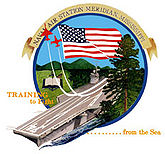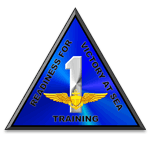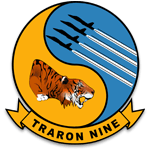Difference between revisions of "Naval Air Station Meridian/McCain Field (KNMM) Lauderdale County (MS)"
From The RadioReference Wiki
(Created page with "thumb|190px|NAS Meridian ==General Information== Just 15 miles northeast of downtown Meridian lies Naval Air Station Meridian jet training facilit...") |
m |
||
| Line 1: | Line 1: | ||
| − | [[Image:NAS_Meridian_logo.jpg|thumb| | + | [[Image:NAS_Meridian_logo.jpg|thumb|165px|NAS Meridian]] |
==General Information== | ==General Information== | ||
Just 15 miles northeast of downtown Meridian lies Naval Air Station Meridian jet training facility. NAS Meridian hosts Training Wing One and training squadrons VT-7 and VT-9. The main base of NAS Meridian occupies more than 8,000 acres, with an additional 4,000 acres at Joe Williams Field and the target facility SEARAY. The size of NAS Meridian may be compared to that of other major naval air stations such as NAS Pensacola, Fla., which has about 5,000 acres. More than 4,000 military, civilians and dependents work and/or live at the air station. | Just 15 miles northeast of downtown Meridian lies Naval Air Station Meridian jet training facility. NAS Meridian hosts Training Wing One and training squadrons VT-7 and VT-9. The main base of NAS Meridian occupies more than 8,000 acres, with an additional 4,000 acres at Joe Williams Field and the target facility SEARAY. The size of NAS Meridian may be compared to that of other major naval air stations such as NAS Pensacola, Fla., which has about 5,000 acres. More than 4,000 military, civilians and dependents work and/or live at the air station. | ||
Revision as of 11:44, 23 March 2014
Contents
General Information
Just 15 miles northeast of downtown Meridian lies Naval Air Station Meridian jet training facility. NAS Meridian hosts Training Wing One and training squadrons VT-7 and VT-9. The main base of NAS Meridian occupies more than 8,000 acres, with an additional 4,000 acres at Joe Williams Field and the target facility SEARAY. The size of NAS Meridian may be compared to that of other major naval air stations such as NAS Pensacola, Fla., which has about 5,000 acres. More than 4,000 military, civilians and dependents work and/or live at the air station.
Training Air Wing One (TW1)
raining Air Wing ONE was commissioned on August 2nd, 1971. The mission of Training Air Wing ONE is to provide newly designated aviators to the fleet for further training in operational combat aircraft and is conveyed in the wing motto, "Readiness for Victory at Sea Through Training." The Wing Commander's specific mission is to supervise, coordinate, and administer the student pilot academic and flight-training program. The instructor pilot cadre at Training Air Wing ONE is comprised of men and women from almost every Navy and Marine Corps aviation community as well as several international military exchange pilots, bringing an enormous array of fleet experience to the training command. Training Air Wing ONE is also tasked with training international military aviators from countries including France, Italy, and Spain.
Training Squadron SEVEN (VT-7) "Eagles"
- Aircraft - T-45 Goshawk
- Callsign - "TALON ###"
The "Eagles" of Training Squadron SEVEN (VT-7) have the mission of safely and effectively training the world's finest Naval Aviators and preparing them for service and success in the Fleet. Student Naval Aviators train for approximately twelve months in the fundamentals of strike aviation. Initial flights and simulators are devoted to Instrument Flight Rules, culminating in an instrument rating. In the Familiarization stage, students learn basic aircraft maneuvering, aerobatics, and landing skills foundational to the aircraft carrier environment. Numerous multi-aircraft flights provide requisite skills in two-plane, four-plane, and night formation flying. The second phase of flight training exposes students to manual air-to-ground bombing, Tactical Formation, Air Combat Maneuvering, and Operational Navigation at low altitude. Finally, students perform Field Carrier Landing Practice (FCLP) in preparation for their Carrier Qualifications (CQ). In order to become "tailhookers" and earn their Wings of Gold, students must safely complete four touch-and-go’s and ten arrested landings aboard a carrier at sea.
Training Squadron NINE (VT-9) "Tigers"
- Aircraft - T-45 Goshawk
- Callsign - "BOBCAT ###"
Training Squadron NINE (VT-9)is the third naval squadron to be designated VT-9. The first VT-9 was commissioned in 1927 as a torpedo squadron, flying the Curtis T-3M Convertible Land/Seaplane. The second VT-9 was commissioned on December 15, 1961 at McCain Field, U.S. Naval Air Station, Meridian, Mississippi. On August 2, 1971, the VT-9 "Tigers" branched off to form its "sister" squadron, designated VT-19 "Frogs", and both squadrons then assumed the intermediate jet training role at Meridian. Training Squadron NINE was disestablished in July 1987 and consolidated with Training Squadron NINETEEN. On October 1, 1998, Training Squadron NINETEEN was re-designated as Training Squadron NINE and the "Tigers" were again reborn. In June 2004, the squadron completed the last Student Naval Aviator flight in the T-2C "Buckeye".
Outlying Fields
Wiki Articles
- Camp Shelby Joint Forces Training Center
- Gulf States Milcom
- Trent Lott Combat Readiness Training Center Harrison County (MS)
- United States Department of Defense (BEE00-14C)



